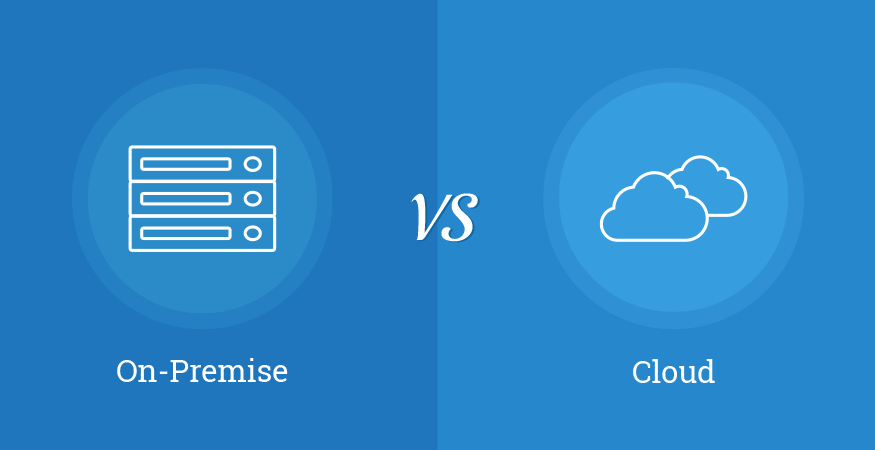Cloud-based BPM platforms are taking the application development market by storm. But does that mean on-premise software is becoming obsolete?

Like the daily newspaper that many thought would be dead by now, on-premise business process management tools are probably here to stay for the foreseeable future because a lot of enterprise IT directors are not convinced that their enterprise data is ready to transition to the cloud. Many enterprises prefer on-premise BPM software because it is tangible, visible, and exists within the enterprise boundaries. IT leadership feels that they have to have datacenters within their ‘jurisdiction’ in order to keep their corporate data safe.
On-premise vs. Cloud-based Offerings
A shipping company, with a team strength of 500 people, is looking for a BPM solution to manage their customer orders and logistics. They company is looking to expand its operations in the Asia-Pacific region and needs a swift business process management tool to ensure faster collaboration across regional offices. They want to keep their customer data within the company walls, but also require a solution that can be stretched further for their growing future needs.
Which solution do you think the company should opt for? On-premise or cloud?
For many enterprises, using an on-premise BPM software evokes a sense of responsibility towards their business processes. They can rely on the software that is caged inside company-owned hardware and runs on the operating system that the IT team installed. ‘On-prem’ is a time-tested approach to manage business processes that requires company servers and hosting assets paid for by the enterprise.
Cloud-based applications are radical in their offering because they take the responsibility of hosting servers away from an enterprise. BPM systems built on the cloud have distinct features that drastically contrast from on-premise options:
- Cloud-based BPM provide an on-demand, flexible le solution.
- Services can be easily scaled based on an enterprise’s growing requirements.
- The services are charged by like user licensing, storage consumption, gigabytes used, CPU cycles, etc.
- They have a broader bandwidth because they are deployed on the internet.
- They make use of resource pooling with other systems on the cloud.
Cloud services are offered either through Software as a Service (SaaS), Platform as a Service (PaaS), or Infrastructure as a Service (PaaS) – service models that cater to a wider range of enterprise and their requirements.
Additionally, a Cisco White Paper on Global Cloud Index forecasted that public cloud usage is going through a steady spike since 2014. The domain will be claiming as much as 56% of the enterprise cloud workloads by 2019, the report says.
Should We Steer Clear of On-Prem?
On-premise BPM platform is perfect for your enterprise if you have trust issues with cloud vendors and if you can afford to have dedicated resources to provision your business processes.
Cloud-based applications are designed for user ease and faster deployment and they are mostly popular among small and medium businesses (SMBs) who want enterprise-level solutions within a smaller budget. They choose cloud-based BPM software because they don’t have the expertise to build such solutions on-premise and on their own, and having an out-of-the-box web product gives them the thrust to focus on their core business competencies. When they use cloud-based business process management solutions, they might only have to look after certain aspects of the process that cloud vendors don’t offer, like desk-side customer support.
If you are considering buying on-premise BPM, here are a few situations where the product might have an edge over cloud BPM.
- Many countries or industry verticals expect businesses to comply with a number of regulations on handling and storing sensitive data. One such example is HIPAA compliance for the healthcare industry in the US, that requires enterprises to maintain private datacenters.
- Although cloud security is a non-issue among most cloud vendors, many enterprises with a high focus on data security are more comfortable having on-premise solutions within their reach.
- Companies with operations across many countries, some of which have patchy internet bandwidth or content censorship, can improve latency and consistency in data exchange by having a WAN circuit that connects their private datacenters.
- Data visibility, much like the security issue, is another perceived area where enterprise find onsite solutions preferable, because they know where their data is located. Unless the cloud vendors come up with a technology to make data visible to the owners, many enterprises are going to be skeptical about the issue.
Are On-premise And Cloud Solutions Mutually Exclusive?
This is where most IT directors get it wrong.
Choosing between on-premise and cloud solutions shouldn’t be a difficult dilemma; you can choose them both for processes that have different requirements. For example, an enterprise might want to have their email system on-prem while using a cloud-based system to ensure communication speed and archiving capability. In another case, a manufacturing company might want cloud services for QA on its products for faster computing and cost-effective testing, while having an onsite software for deploying its production system.
The key is to recognize that some processes are easier and of low impact to transport over to cloud, whereas certain data are mission critical to business that needs to be safeguarded within the enterprise periphery. Therefore, deciding which option to use really depends on the nature of your business, the processes you have, and your level of comfort with cloud vendors.
If your company is dedicated to on-premise solutions, you aren’t dead-in-the-water quite yet. Many businesses will be able to function well with these solutions for many years to come. However, there will come a day soon when the cost of maintaining these solutions will significantly outweigh the lingering minor security issues that come with storing data on the cloud.